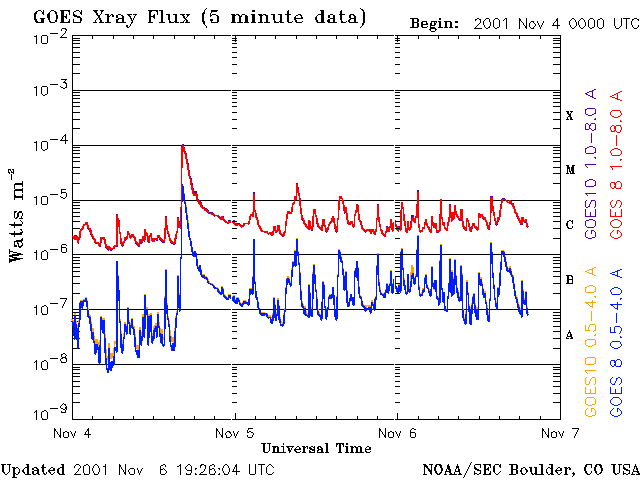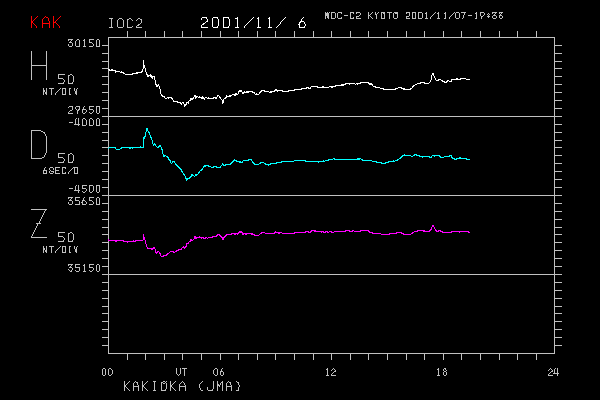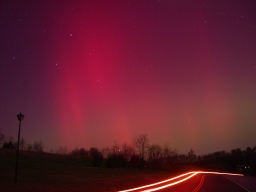Geophysical Activity Forecast:
The geomagnetic field is expected to be active to major storm levels on the first day of the forecast period. A coronal mass ejection (CME) from the X1 event on 04 November is expected to impact the geomagnetic field early on 06 November. Major storming is expected with isolated severe storming possible at higher latitudes. Conditions are expected to decrease to unsettled to minor storming on the second day and quiet to active on the third. However additional CME's may have been produced by several long duration flares that occurred after the X1 event. It is nearly impossible to detect these events as the LASCO imagery has been degraded by the current proton storm. If there are subsequent CME's, the geomagnetic storming could continue into the second and third day of the forecast period.
Further e-mail, next morning
Subject: Re: Colors in the sky
Date Tue, 6 Nov 2001 08:47:27 -0600
From: Jim
Dr. Stern, Thank you!
I'll sit down with my son (and wife) and look at the links tonight. I appreciate the time and effort you put into the response. We don't see too may heavenly phenomena in Chicago; heck, we hardly see stars. Thanks for clarifying! Son's name is Joe, he's 11, and inquisitive. It was a neat family moment; the 3 of us out front, him in a Boy Scout uniform, seeing a colored sky!
Reply:
Subject: Re: Colors in the sky
Date: Tue, 06 Nov 2001 10:19:27 -0500
Hello, Jim
Thanks for your letter--but I should caution you. It also could be a vapor release from a high altitude rocket, or from the space shuttle (if it is in orbit now--I do not know). An aurora is predominantly green, and it is likely to be constantly changing--see
http://www.phy6.org/Education/waurora1.html
A high altitude release of barium (green) or lithium (red) will be in the eastern sky, usually within an hour or so of sunset. It will not change shape appreciably. The vapors are released to trace winds and electric fields in the high atmosphere, and to be visible they must be illuminated by sunlight, while the observer below already sees a dark sky. That is why they are seen after sunset. See also http://www.phy6.org/Education/wposion.html
Belay that!
Subject: Aurora
Date: Tue, 06 Nov 2001 11:13:48 -0500
Hello, Jim, Ingrid and Joe
Belay my last message--what you saw probably WAS an aurora. I just got a call from my son Allon, in Purcelville, Virginia, telling me about the aurora he saw around midnight, last night. He took photos of it (which he may post on the web) and said (probably based on web information) that it was seen all the way to Texas. It started red (high altitude aurora from relatively low energy electrons) and then changed to green, the usual auroral color, emitted at about 60 miles.
I myself went out to the porch after reading your message, around 11 pm, trying to see if an aurora was visible. But the sky in Greenbelt is not as dark as in rural Virginia, and trees here obscure the sky near the northern horizon, so I saw nothing.
Reply from Jim:
Subject: Re: Colors in the sky
Date Tue, 6 Nov 2001 09:36:37 -0600
Thanks again Dr. Stern. For simplicity sake, I'm going to have to call it an aurora. It was mostly green, and fairly easy to understand. I can't wait to share w Joe!
Reply from Ingrid:
Subject: Re: Aurora
Date: Tue, 6 Nov 2001 10:39:10 -0600
David-
Thank you for all your detailed information. I went out to walk the dog with a friend at 8:45 and experienced something that I never have before. The sky had streams of bright white lights coming from different directions with a blue/green hue in the background and with huge pockets of an orange glow in different areas. It sure was something to look at. Simply beautiful. Thanks again for all the info - Ingrid
Further comment:
Dear Ingrid
So much in life depends on the right timing! The way you timed taking your dog for a walk was near-perfect. I am attaching here a plot of the magnetic observatory in Kakioka, Japan, which posts its observations on the web every day at
http://swdcdb.kugi.kyoto-u.ac.jp/imagdir/imag1/q/KAKrtoday.html
(cited on http://www.phy6.org/Education/wmagstrm.html and copied below)
|  Aurora north of Chicago, even overhead, is not unheard of. See the
illustration on my web page on space weather [copied on the right]
Aurora north of Chicago, even overhead, is not unheard of. See the
illustration on my web page on space weather [copied on the right]


 At midnight Eastern time, or 5 am UT, my son watches the aurora in Virginia. His pictures (one of which is shown here) are on
At midnight Eastern time, or 5 am UT, my son watches the aurora in Virginia. His pictures (one of which is shown here) are on